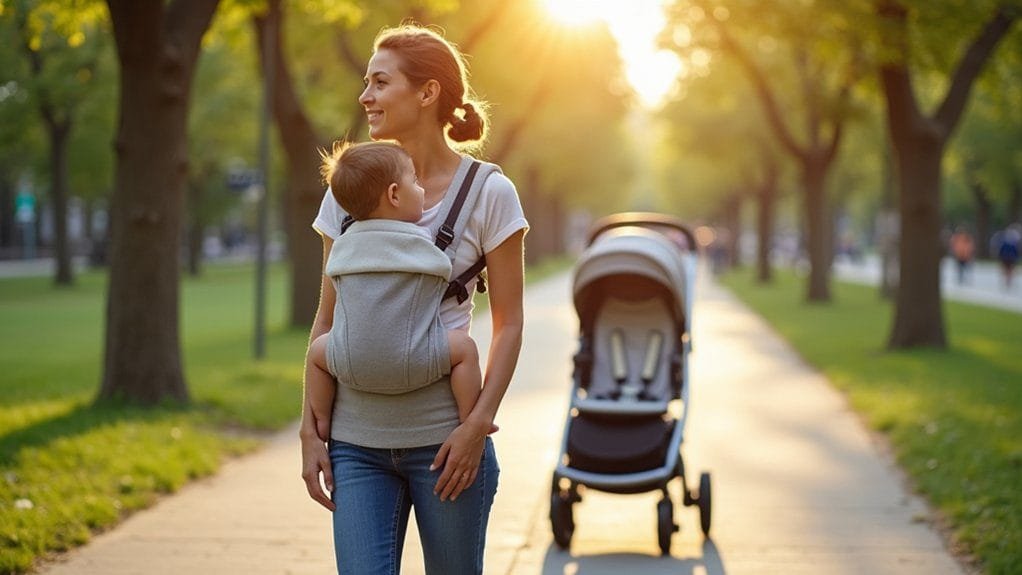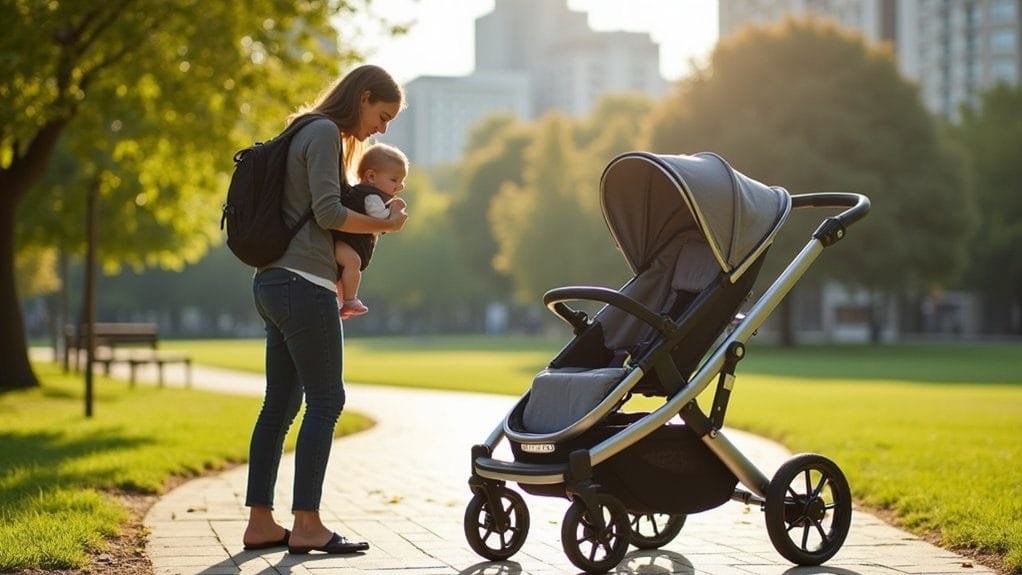When traveling with your infant, your choice between a baby carrier and stroller depends on destination and activity. Carriers offer superior mobility in tight urban spaces and simplify airport navigation, while strollers provide structured seating and storage for longer trips. Urban environments favor carriers; smooth pathways suit strollers. Consider terrain, climate, and trip duration. Safety features and ergonomic design are critical. Your perfect travel solution awaits further exploration.
Key Takeaways
- Baby carriers excel in mobility, offering close contact and ease of navigation through tight spaces during urban travel and airport transit.
- Strollers provide superior comfort for longer trips, with storage capabilities and structured seating support for infants during extended journeys.
- Travel terrain significantly influences the choice: carriers are ideal for uneven landscapes and hiking, while strollers work best on smooth pathways.
- Hybrid approaches combining both a lightweight carrier and compact stroller offer maximum flexibility across diverse travel scenarios and destination types.
- Safety considerations are paramount, with carriers requiring ergonomic weight distribution and strollers needing reliable brake mechanisms and harness systems.
Essential Considerations for Traveling With Baby Gear


When traveling with an infant, selecting the right baby gear can make or break your journey. Your choice between a baby carrier and stroller depends on multiple travel-specific factors. Baby carriers offer superior mobility and simplify airport navigation, providing hands-free movement through crowded spaces. They’re lightweight, compact, and eliminate complex security check procedures. Strollers, conversely, provide storage capacity and comfortable resting environments for longer outings. Consider your destination’s terrain and accessibility when making your selection. Urban environments with smooth pathways favor compact strollers, while uneven landscapes demand the adaptability of baby carriers. Critically evaluate the advantages and disadvantages of each option. Experienced travelers often recommend a hybrid approach—bringing both baby carriers for travel and a lightweight stroller—to maximize flexibility and comfort during your trip. Your infant’s age, journey duration, and specific travel requirements should guide your gear selection.
Baby Carriers: Advantages and Limitations
While maneuvering the complexities of infant travel gear, baby carriers emerge as a strategic solution for mobile parents seeking versatile transportation options. These compact devices offer hands-free mobility, enabling you to navigate challenging travel environments with enhanced agility. However, they’re not without limitations.
| Advantage | Limitation | Consideration |
|---|---|---|
| Close contact | Potential overheating | Temperature management |
| Lightweight | No storage space | Additional bag planning |
| Security screening ease | Caregiver fatigue | Ergonomic rotation |
| Terrain flexibility | Limited infant weight capacity | Age-appropriate selection |
| Bonding opportunity | Physical strain potential | Proper usage technique |
Baby carriers provide critical proximity between caregiver and infant, promoting psychological comfort during transit. Their technical design facilitates seamless movement through airports and uneven landscapes. Nonetheless, parents must critically assess individual travel requirements, personal physical capacity, and infant’s developmental stage when selecting appropriate transportation solutions.
Strollers: Benefits and Drawbacks


Shifting from the intimate portability of baby carriers, strollers represent an alternative mobility solution with distinct ergonomic and practical considerations for travel. When selecting a travel system, you’ll find strollers offer structured seating that provides ideal back support and comfort for your baby during extended outings. They’re particularly advantageous in urban environments, featuring storage compartments that enable you to carry additional items without physical strain.
However, strollers aren’t without limitations. Their bulky design can become challenging in confined spaces, and traversing uneven terrains like cobblestones or stairs proves difficult. Airline transportation introduces further complexities, with potential risks of damage during check-in. While beneficial for rest and mobility, strollers demand careful evaluation of your specific travel context to determine their practicality and effectiveness.
Travel Scenarios: When to Choose a Carrier or Stroller
Because travel dynamics vary greatly across different environments and activities, selecting between a baby carrier and a stroller requires a strategic assessment of your specific mobility needs and destination characteristics. Urban sightseeing and air travel typically favor baby carriers, offering enhanced mobility through tight spaces and simplified security processes. Conversely, longer trips demanding comfortable seating and storage benefit from strollers. Outdoor terrain greatly influences your choice—hiking trails and rugged landscapes call for lightweight carriers, while smooth pathways accommodate strollers effectively. Climate also plays a critical role; warmer environments might render carriers uncomfortably hot, making strollers with protective canopies more suitable. Your travel scenario’s unique demands will dictate whether a carrier or stroller provides ideal baby transportation, ensuring both parental convenience and infant comfort.
Climate and Activity-Based Travel Recommendations


When selecting travel baby transportation, parents must strategically evaluate climate and activity parameters to guarantee ideal infant safety and comfort. The best baby carrier makes traversing diverse environments effortless, while travel strollers provide structured mobility. In warm climates, breathable mesh carriers help your baby regulate temperature during outdoor activities, whereas strollers with extensive canopies offer vital sun protection. Urban environments with challenging terrains demand lightweight, adaptable baby carriers that facilitate easy public transport navigation. Climate and activity directly influence transportation choices: beach vacations benefit from strollers for transporting essentials, while hiking necessitates compact carriers for maneuverability. Cold weather scenarios require careful consideration, with carriers providing body-heat advantages and strollers offering protective weather covers. Strategic selection guarantees infant comfort and parental convenience across diverse travel conditions.
Practical Tips for Navigating Transportation
How can parents strategically navigate transportation challenges when traveling with infants? Understanding the best travel equipment is essential for smooth journeys. When selecting between a stroller and baby carrier, consider transportation dynamics and specific travel contexts.
Key strategies include:
- Choose a lightweight, compact baby carrier for airport security checkpoints, enabling faster navigation and hands-free movement
- Gate-check strollers to maintain accessibility during long airport transfers and provide additional luggage transportation capacity
- Utilize a hybrid approach, alternating between carrier and stroller based on distance, terrain, and specific travel segment requirements
Effective travelers recognize that successful infant transportation depends on adaptability. A well-planned combination of baby carrier and stroller can optimize mobility, reduce physical strain, and guarantee comfortable transit across diverse travel environments. The goal is seamless navigation while maintaining infant comfort and parental convenience.
Feeding and Comfort Strategies
While traveling with infants presents unique nutritional and comfort challenges, parents can strategically leverage both baby carriers and strollers to optimize feeding and rest experiences. Baby carriers facilitate discreet breastfeeding on-the-go, promoting skin-to-skin contact and temperature regulation during travel. For older babies moving to solid foods, a stroller with a tray enables controlled feeding while maintaining close supervision. Carriers offer intimate feeding proximity, whereas strollers provide a stable platform for snack consumption. Each option presents distinct advantages for infant nutrition and comfort during travel.
The key is selecting the appropriate feeding strategy based on the baby’s age, developmental stage, and specific travel environment. Stroller canopies protect against sun exposure during outdoor meals, while carriers require additional protective measures. Parents should prioritize safety, comfort, and nutritional needs when choosing between carrier and stroller feeding approaches.
Packing and Luggage Management
Although travel logistics can overwhelm parents, strategic packing of baby transportation gear demands meticulous planning and space-conscious decision-making. When evaluating luggage management options, you’ll find that baby carriers offer superior compactness and lightweight advantages over traditional strollers. Your travel efficiency hinges on selecting gear that minimizes storage requirements while maximizing mobility.
Consider these critical packing strategies:
- Rent strollers at destinations to reduce luggage volume
- Use baby carriers as primary transportation in compact spaces
- Leverage hybrid approaches combining carriers and compact strollers
Precise selection of baby transportation equipment can dramatically simplify travel challenges. By prioritizing space-efficient solutions and understanding each gear’s storage implications, you’ll optimize your travel experience, ensuring seamless movement through airports, hotels, and various transit environments while maintaining your infant’s comfort and safety.
Safety and Ergonomic Factors
When selecting baby transportation for travel, parents must prioritize safety and ergonomic design to protect their infant’s well-being and prevent caregiver fatigue. Safety features differ between baby carriers and strollers, with each offering unique benefits. Ergonomically designed carriers distribute weight evenly, reducing strain, while strollers provide structured seating support.
| Baby Carriers | Strollers |
|---|---|
| Harness systems | Brake mechanisms |
| Weight distribution | Adjustable positions |
| Close body contact | Sun protection canopies |
| Infant support | Secure restraint systems |
| Compact design | Wheel stability |
Choosing products that meet recognized safety standards is essential. Look for adjustable features that accommodate your child’s growth and development. Whether selecting a baby carrier or stroller, prioritize infant support, ergonomic design, and thorough safety mechanisms to guarantee a secure and comfortable travel experience for both parent and child.
Expert Recommendations for Family Travel
Because travel dynamics with infants require strategic planning, pediatric travel experts recommend a thorough approach to baby transportation that balances mobility, comfort, and safety. When traveling with a baby, consider these expert recommendations:
- Strategically use a baby carrier for maneuvering crowded spaces and quick changes, while keeping a stroller available for longer journeys and potential rest periods.
- Evaluate destination-specific terrain and climate to determine whether stroller travel or baby carrier usage will be more practical and comfortable.
- Select versatile baby transportation options that allow seamless changes when the baby is sleeping or during varied travel environments.
Your approach should prioritize flexibility, ensuring you can efficiently manage different travel scenarios while maintaining your infant’s comfort and security. Stroller vs. baby carrier decisions ultimately depend on specific travel contexts and individual family needs.
Frequently Asked Questions
Which Is Better, a Stroller or a Baby Carrier?
You’ll find each option offers unique benefits: carriers provide comfort and accessibility, while strollers offer convenience. Your travel needs, terrain, and baby’s age will determine the most space-efficient, weight-considerate, and flexible solution.
Is It Worth Bringing a Stroller on a Plane?
You’ll find bringing a lightweight stroller beneficial if it meets gate-checking requirements, offers easy folding mechanisms, and guarantees infant safety. Consider in-flight storage limitations, comfort factors, and airline-specific regulations before deciding on travel convenience.
What Is the Best Way to Travel With a Baby?
You’ll want to prioritize versatile baby essentials and smart packing strategies. Combine a lightweight carrier and compact stroller for airport navigation, ensuring your baby’s comfort, safety, and your ease of on-the-go parenting during travel.
What Are the Disadvantages of a Baby Carrier?
You’ll face comfort issues with baby carriers, experiencing back pain, temperature concerns, and limited storage. Weight limitations can strain your body, while skin irritation and accessibility challenges may compromise your and your baby’s travel experience.
Conclusion
When traveling with your little one, you’ll want to weigh portability against convenience. Carriers offer intimate bonding and mobility, while strollers provide storage and rest. Choose based on your destination’s terrain, planned activities, and your baby’s age and comfort. By understanding each option’s strengths, you’ll make a smart, safe choice that enhances your family’s travel experience, ensuring comfort and practicality wherever your journey takes you.
